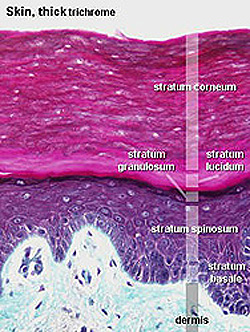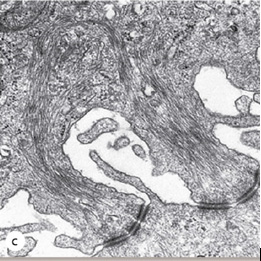 Thick
skin - present on fingertips, palms, and soles of feet, it is
specialized for protection from friction and contains many sensory
receptors, associated cell types and structures. Thick
skin - present on fingertips, palms, and soles of feet, it is
specialized for protection from friction and contains many sensory
receptors, associated cell types and structures.
Examine a section of thick skin (sample
1 and sample 2) and identify epidermis and
dermis. and sample 2) and identify epidermis and
dermis.
- In the dermis, note the difference
between the papillary and reticular layers.
- Note, too, how downward
epidermal folds or ridges interdigitate with upward
projecting dermal papillae.
- In the epidermis, identify
characteristic cells, keratinocytes,
representing the
- Stratum basale,
- Stratum spinosum,
- Stratum granulosum, and
- Stratum corneum
- Click image to right for
expanded view.
- The strata grade into one another
and cells gradually move outward from the basal layer to the
cornified layer.
 Note
he ultrastructural features of the
intercellular connections of the keratinocytes.Desmosomes are
extraordinarily abundant in the stratum spinosum, helping hold
adjacent cells, as well as the layers of cells together. Desmosomes are
integrated with the high molecular weight keratin intermediate
filament network, and together, these help the epidermis resist
mechanical strains such as friction. (Image from Junqueira’s Basic
Histology 14th edition) Note
he ultrastructural features of the
intercellular connections of the keratinocytes.Desmosomes are
extraordinarily abundant in the stratum spinosum, helping hold
adjacent cells, as well as the layers of cells together. Desmosomes are
integrated with the high molecular weight keratin intermediate
filament network, and together, these help the epidermis resist
mechanical strains such as friction. (Image from Junqueira’s Basic
Histology 14th edition)
The skin as a route of
medication delivery. |